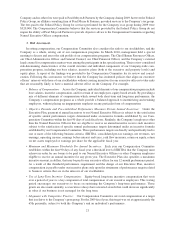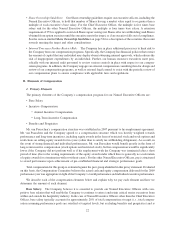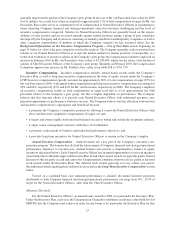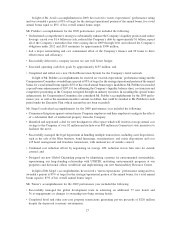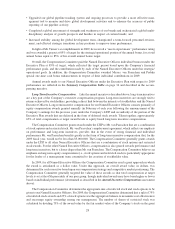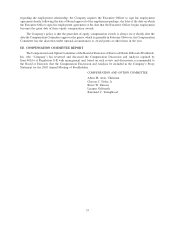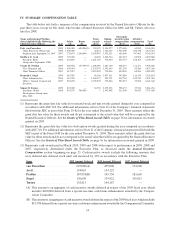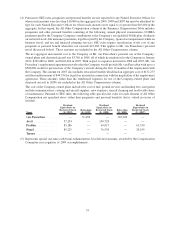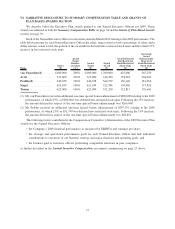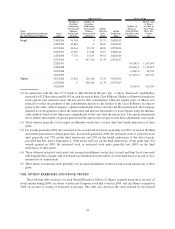Starwood 2009 Annual Report Download - page 38
Download and view the complete annual report
Please find page 38 of the 2009 Starwood annual report below. You can navigate through the pages in the report by either clicking on the pages listed below, or by using the keyword search tool below to find specific information within the annual report.date. The number of stock options was determined by dividing the remaining 25% of the award value by the
fair market value of the Company’s stock on the grant date and multiplying the result by two and one-half. The
Named Executive Officers are able to elect a greater portion of options (up to 100% options). Based on the
factors set forth above, including the Company’s performance and individual performance of each Named
Executive Officer in 2009, the Compensation Committee believes that equity award grants in 2009 were
appropriate.
The exercise price for each stock option is equal to fair market value of the Company’s common stock on
the option grant date. See the section entitled Equity Grant Practices on page 32 below for a description of the
manner in which we determine fair market value for this purpose. Currently, most stock options vest in 25%
increments annually starting with the first anniversary of the date of grant. For stock options granted in 2009,
awards granted to associates who are retirement eligible, as defined in the LTIP, vest in 16 equal quarterly
periods. Unexercised stock options expire 8 years from the date of grant, or earlier in the event of termination
of employment. Stock options provide compensation only when vested and only if the Company’s stock price
appreciates and exceeds the exercise price of the option. Therefore, during business downturns, option awards
may not represent any economic value to an executive.
Named Executive Officers have a mandatory deferral of 25% of their awards under the Executive Plan in
the form of deferred stock awards, unless reduced in the discretion of the Compensation Committee. As such,
the awards combine performance-based compensation with a further link to stockholder interests. First,
amounts must be earned based on annual Company financial and strategic/operational performance under the
Executive Plan. Second, these already earned amounts are put at risk through a vesting schedule. Vesting
occurs in installments for employment over a three-year period. Third, these earned amounts become subject to
share price performance. Primarily in consideration of this vesting risk being applied to already earned
compensation (but also taking into account the enhanced stockholder alignment that results from being subject
to share performance), the deferred amount is increased by 33% of value. For awards granted in 2009 or later,
vesting will accelerate in the event of death, disability or retirement.
Restricted stock awards and restricted stock provide some measure of mitigation of business cyclicality
while maintaining a direct tie to share price. The Company seeks to enhance the link to stockholder performance
by building a strong retention incentive into the equity program. Consequently, for 2009 grants, 100% of
restricted stock units and awards vest on the third anniversary of the date of grant. For restricted stock granted in
2009, awards granted to associates who are retirement eligible, as defined in the LTIP, vest in twelve equal
quarterly periods. This delayed vesting places an executive’s long-term compensation at risk to share price
performance for a significant portion of the business cycle, while encouraging long-term retention of executives.
Pursuant to his employment agreement, Mr. van Paasschen agreed not to sell any Company stock awards
or Shares received on exercise of options (except as may be withheld for taxes) without prior consultation with
the Board of Directors.
Benefits and Perquisites. Base salary and incentive compensation are supplemented by benefits and
perquisites.
Current Benefits. The Company believes the employee benefits it provides are consistent with local
practices and competitive markets, including group health benefits, life and disability insurance, dependent
care flexible spending accounts, health savings account, and a pre-tax premium payment arrangement. Each of
these benefits is provided to a broad group of employees within the Company and our Named Executive
Officers participate in the arrangements on the same basis as other employees.
Perquisites. As reflected in the Summary Compensation Table below, the Company provides certain
limited perquisites to select Named Executive Officers when necessary to provide an appropriate compen-
sation package, particularly in connection with enabling the executives and their families to smoothly
transition from previous positions which may require relocation. For example, Mr. van Paasschen and his
immediate family had access to a Company owned or leased airplane on an “as available” basis for personal
travel, i.e., assuming such plane was not needed for business purposes, with an obligation to reimburse for
personal use based upon the Company’s operating cost. The Company also reimburses Named Executive
29




